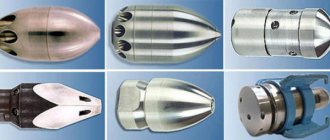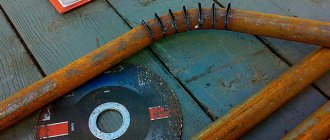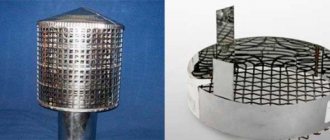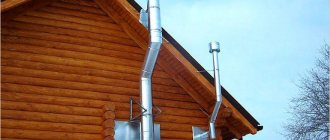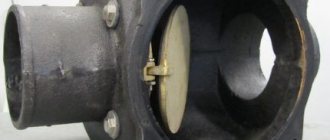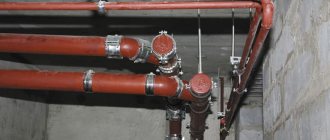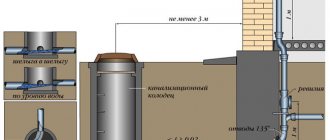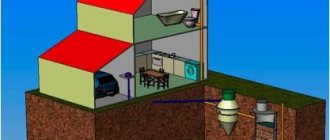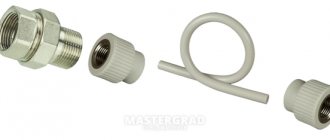There are places where it is impossible to install a standard size, and the product has to be shortened. Since cast iron is quite difficult to process, cutting it at home is almost impossible.
Installation of sewerage system
First, the pipeline axes are marked.
Then the fasteners are mounted, assemblies are assembled from fittings, pipes and pipes. Correctness in horizontal and vertical positions is checked. Fastening is being carried out. The pipe is cut to size immediately before installation to allow for “trying on”.
Cutting into pieces of a given length when installing water supply and sewerage pipes is done with a regular hacksaw for metal. The end is cleaned with a file and chamfered at an angle of 15°.
It is unacceptable to place socket connections between floors or change the angle of inclination from the calculated one in horizontal sections.
Methods for laying sewer pipes
Installation of a new system begins with sealing the socket of the first element on the riser tee, taking into account the angle of inclination of the pipeline. Fixation is carried out using fastening clamps to the wall or floor.
The parts to be joined must be clean and without visible damage or deformation in diameter. Rejection should be done at the acquisition stage.
Installation of plastic sewer pipes is carried out so that the smooth end does not enter the socket all the way. Temperature fluctuations and, as a consequence, changes in pipe length should be taken into account. An expansion gap of 10 mm will ensure the system is tight during temperature changes. For pipe lengths of 3-10 m, expansion couplings are used.
Silicone sealant will provide reliability to the joint. The outer part of the pipe is lubricated with sealant (lubricant cannot be used inside).
During installation, it is important to comply with the requirements for the slope of sewer pipes. The use of sound-absorbing pipes (longitudinal stripes of green and red color) will reduce the complexity of installing a sewerage system
But you should take into account the high cost of such products
The use of sound-absorbing pipes (longitudinal stripes of green and red color) will reduce the complexity of installing the sewerage system. But you should take into account the high cost of such products.
Noise control: sound-absorbing pipes and sewer pipe soundproofing
Therefore, to reduce sound from sewer drains, the pipe can be insulated. Risers located close to the bedrooms, kitchen or living room need soundproofing. If the riser passes in a place remote from the constant presence of people, then the need for protection from sound vibrations disappears.
The assembled system must be checked for leaks. Having collected water in buckets in advance, you need to quickly pour it into the device being tested: washbasin, sink, bathtub. The leak site should be disassembled and resealed.
Instructions for assembling sewerage pipelines (in text or video formats) will allow you to avoid cleaning, noise from the movement of drains, repair of deformed elements and other unpleasant moments during further operation of the system.
How to install pipes
In fact, pipes made of cast iron are currently extremely rarely installed in country houses, as they have many disadvantages. We talked about them above. In particular, if you decide to install the sewer system yourself, it is simply unreasonable to use cast iron pipes. First, you need a wealth of work experience. Secondly, it is much more difficult to lift and install pipes on your own; you will have to seek help.
Installation of cast iron pipes is not much different from installation of plastic or asbestos pipes. It is necessary to mark the places where you plan to install the pipes. If you are screeding the floor, leave space under the tee coming from the riser. This must be done in order to subsequently avoid violating the integrity of this same tee during settlement. You also need to decide how the pipe will be fixed to the wall.
The simplest option is clamps that need to be installed on the pipeline below the pipe junction. In this case, it is necessary to remove adjacent fastenings from each other by 1-2 m if the riser is vertical. If the pipes are located horizontally, then the distance should correspond to ten times the diameter.
Using clamps, you can make both rigid and non-rigid connections. In the first case, metal clamps must be tightened as tightly as possible. Between it and the pipe you need to install a rubber gasket. In the second case, the gasket is not used, and the clamp is not tightened all the way. In both cases, you will avoid creating excessive stress in the pipes.
It is extremely important to maintain the distance from the riser to the wall - it should be about 40 cm. But there is another method for attaching the pipes, in which they are hidden inside the walls. It is necessary to make grooves in the walls according to the markings. These are channels whose width is slightly larger than the diameter of the pipe. In this case, you can avoid excessive stress in the pipe walls. Immediately before laying in this groove, it is necessary to wrap the entire surface with soft material.
If necessary, the pipes are wrapped with heat insulation. Now it is allowed to apply plaster to the wall to disguise the groove. In this case, you will hide the sewer from prying eyes. After choosing the fastening method, you can begin installation. The first step is to prepare the entire system, secure the clamps or make grooves. The second step is to assemble the entire pipeline. The connection method directly depends on whether pipes with or without sockets are used.
Installation of ductile iron pipes for RJ connection Watch this video on YouTube
There are several docking methods. Thanks to a wide range of options, it becomes possible to select the most suitable method, taking into account the operating conditions of the pipeline. Overview of connection types:
- Trumpet. Communications in this case have an expansion on one side. It resembles a cuff. A rubber gasket is installed in the socket. Then a pipe is inserted into this expansion. The result is a reliable, durable connection. However, its quality is determined by the characteristics of the gasket. If the rubber becomes deformed or loses its properties, which often happens during long-term use, a leak will form. It can be eliminated by replacing the gasket.
- Sealing method. In this case, communications with a socket are used, but the gasket is not installed at the joint. The cracks are filled with tow and then cemented.
- Socketless connection. In this case, an adapter in the form of a coupling is used. Communications are installed into this product on both sides. Then, in this section, the pipeline elements are tightened using metal clamps.
- Plastic docking. Docking according to this principle is performed when it is necessary to connect sections of cast iron and plastic pipelines. For this purpose, special adapters and sealant are used.
Methods for caulking sewer pipes
In this case, a cement mixture and tow are used. Using these materials, you can caulk cracks in the socket joint when a rubber gasket is not used. This method is considered the most reliable, due to the use of cement mortar. The caulking technology is implemented in stages:
- first, two pipes are connected, and the size of the gap should not be less than 3 mm, otherwise this method will be difficult to implement;
- tow is driven into the gap between the pipes using a narrow spatula, screwdriver, chasing, the depth of filling the gap is 2/3 of the length of the socket;
- the remaining part of the cast iron pipe extension is compacted with cement mortar.
For greater reliability, cement grades M300, M400 should be used. The better the material characteristics, the lower the risk of leakage in the future.
Using cement mortar
In order for the connection of cast iron pipes to serve for a long time, you need to properly prepare the mixture. The recommended ratio of cement and water is 9:1. The remaining free part of the socket is filled with the mixture. Considering that the solution is quite thick, a hammer and a hammer should be used to compact it when filling the metal cuff. These actions are continued until the tool bounces off the solution. To improve the properties of cement, the suture joint is covered with a damp cloth.
It is important to firmly fix the pipeline during work until the solution has completely hardened. You cannot use it for the next 2-3 days, as this may affect the quality of the connection. Cracks appear in the cement layer if the pipeline becomes deformed during the drying process.
Caulking a cast iron pipe
To hammer out a cement-lined sewer pipe, remove the seal using a special hammer. Strong impacts are unacceptable; the cement breaks off into small pieces. After this, the edge of the heel is looked for (a rope wrapped around the pipe to enhance the tightness) and an attempt is made to unwind it. There is no need to pull out the entire cable; it is enough to slightly free up the space and loosen the cast iron pipe entering the socket. It is most convenient to pull out the rope using a hook; if possible (free space), then a screwdriver is squeezed into the gap between the socket and the pipe. Only after the pipe begins to swing is it possible to pull the cast iron pipe out of the socket. To do this, it is pulled back in the transverse direction and scrolled in the end direction.
If difficulties arise during the caulking process (the pipe remains motionless or a significant force is required to loosen it), then this can be explained by two possible reasons:
- pipes have grown together during operation;
- For sealing, they used sulfur rather than a heel with cement.
In the first case, all that remains is to cut off the cast iron pipe with a grinder directly above the socket, then make 2-3 internal cuts with a disk with a smaller diameter
The remains are carefully chipped off with a chisel; it is important to avoid metal elements getting into the sewer. After this, the inside of the bell is cleaned and wiped dry with a rag.
It is more difficult to disassemble cast iron sewer pipes with a sulfur plug; heat treatment of the joint area is required - heating with a blowtorch to several hundred °C; the desired condition is determined visually (the pipe will turn red). In this case, the sealant burns through and the pipe becomes free. An important nuance: it is allowed to remove a cast-iron sewer pipe no earlier than 15 minutes after heating; it is impossible to loosen or influence the hot joints. As in the case of caulking pipes with a heel, blows to the pipes are not allowed; a pipe that has become unusable is carefully unscrewed (without effort and pressure).
The same rules apply when replacing a toilet. It is recommended to follow simple rules: disconnect the water supply, drain the tank to the maximum and disassemble the toilet. When fastened with studs or a nut connection, it is easier to replace the toilet bowl with your own hands: it is unscrewed, loosened and removed from the outlet pipe. It is almost impossible to remove a toilet bowl installed on cement mortar intact, in this case it simply breaks.
Hitting the sewer pipe is strictly prohibited; it is the same as directly hitting cast iron with a sledgehammer. Therefore, the blows are applied to the neck, and then the toilet is broken into pieces. When the base is disconnected, water flows out of it; it is advisable to prepare rags and a bucket in advance to collect it. It is necessary to clean the edges of the cast iron drain pipe from pieces of earthenware. This is done using a chisel or screwdrivers; this stage is very critical (the pipe goes into the floor, and if it is damaged, problems arise). At particular risk are common risers with tees (with cast iron wiring to the bathtub) and old toilets with cement-covered joints; in this case, it is better to entrust the caulking to specialists.
WATCH THE VIDEO
What is cast iron?
In essence, cast iron is undercooked steel, i.e. some intermediate state between steel and raw material. During the smelting process, a large volume of air is blown through the liquid metal, which at high temperatures reacts with carbon, which is an integral part of the raw material, and carbon dioxide is released. In this way, gray cast iron is obtained, the same one that is used for the production of sewer pipes.
Gray cast iron pipes are very heavy products, non-ductile, hence very fragile. Such cast iron pipes cannot withstand shock loads. These properties are a consequence of the fact that carbon is located inside the material. In gray cast iron it is present in the form of small plate-like graphite particles. It is the shape of the plate that determines the not very high physical properties of cast iron.
When substances such as cerium, magnesium and others are added to the metal welding process, carbon (graphite) begins to be modified, i.e. its particles become not plates, but balls. As a result, it acquires the following properties:
- high strength - it is impossible to break such cast iron;
- long-term operation - practice has shown a time period of up to 100 years;
- high ductility - of course, far from reaching the maximum, but such cast iron pipes can be mounted in the form of a circle with a large radius.
This type of cast iron is called high-strength, and its grade is ductile iron.
Beginning and sequence of repairs
The easiest way to dismantle a cast iron sewer is to cut it with a grinder or gas cutter. But it is unacceptable for repairs involving the risers of neighboring apartments or for replacing a toilet. Some problems are eliminated if the embossing method is known in advance, but more often it is clarified during the process of disassembling the system. Before starting work, the water supply line must be turned off. In general, do-it-yourself embossing of cast iron pipes takes place in the following sequence:
- Visual inspection of the sewer system and determining the degree of complexity of the work.
- Determination of the minting method by tapping the cork.
- Direct caulking of sewer pipe sockets.
- Cleaning the remaining area.
- Replacing a new section and hiding the seams of the joints.
Other advantages of ordering the installation of cast iron sewer pipes in our company:
A specialist is ready to come out to inspect the property on the day you contact us. "Garant" works 24 hours, 7 days a week, without weekends and holidays. Therefore, all consultations and approvals take place at a time convenient for the customer.
- Complete solution
The company's craftsmen are provided with the necessary tools. The company's consultants will help you select and purchase the necessary materials at the best price, which will be delivered to the site in a timely manner.
- Optimal prices, cash and non-cash payments
The company’s pricing policy, which is attractive to clients, in no way implies a reduction in the quality of the result. In this case, calculations are carried out in a form convenient for customers.
Installation of cast iron sewerage by the masters of STC "Garant" means reliable operation of the drainage system for many decades!
Security measures
When installing a cast iron pipeline, you must handle such products with care. Cast iron is reliable and durable during operation, but it is a fragile material, which manifests itself during transportation and installation.
During cutting, small pieces of metal may break off. When they enter the pipeline, they help reduce the clearance. In addition, fragments can get into the face and injure the organs of vision. For this reason, it is recommended to wear a protective shield or glasses while working with cast iron communications.
If pipe cutting is performed in a room with installed plumbing fixtures and furniture, it is necessary to maintain their integrity. To do this, before starting dismantling, you should cover all items with a thick cloth.
How to connect pipes? Main options
In order to make a socket connection, you need to follow the following sequence:
- Roll 80 mm resin tape into a bundle. Use it to wrap the smooth edge of the pipe.
- Then the previously wrapped end must be installed in the other socket.
- Using a narrow wooden spatula and a hammer, you need to hammer the harness into the socket so that this seal occupies at least 2/3 of the connection.
- Make sure that the gap is the same between the socket and the pipe installed in it.
- It is necessary to pour a sealant on top - it can be either sulfur or cement, asbestos cement.
The last two solutions are used if you need to make the most rigid connection possible. It is worth noting that it is highly desirable that no winding gets inside the pipe. This will immediately lead to clogging.
As for the socketless pipe, the only difference is in the type of connection; it is made using a durable steel clamp. A cuff is placed on its inner surface. The pipes must be joined to each other, and the joint must be secured using this clamp. Today, plastic pipes are more often used to make systems in homes; they are much easier to install. It’s just that older houses still use cast iron sewers. Therefore, if you decide to install plastic, you must first dismantle it.
Features of the use of cast iron in drainage systems
Despite their significant weight, cast iron sewer pipes continue to be used due to a number of important technical characteristics:
- increased strength:
- high wear resistance;
- resistance to corrosion;
- good soundproofing properties;
- low coefficient of thermal expansion;
- good casting qualities;
- incombustibility and fire resistance;
- environmental safety - during their operation there is no release of toxic substances.
The service life of cast iron sewer pipes can reach 100 years. The service life of cast iron pipes is extended by additional treatment of the products with an anti-corrosion coating - petroleum bitumen or whitened high-strength cast iron. Cast iron sewer pipes are used for the installation of pressure internal and external drainage systems, non-pressure networks and drains.
In sewer systems, in which the load is much higher than in conventional household networks, a cast iron sewer pipe of DN 150 and cast iron sewer pipes of 200 mm are used.
These pipes are used:
- at catering outlets, in the food industry, in the beverage industry;
- at large slaughterhouses, farms and other places associated with keeping animals, meat processing plants;
- in sanatoriums with thermal and mineral waters;
- in medical and educational institutions;
- in laboratories.
Assortment of cast iron pipes and fittings for network installation
The diameter of a cast iron sewer pipe is 50-150 mm, pipes made of high-strength cast iron – up to 500 mm. For pipes with a diameter of 50-150 mm, the gap width should be 5-6 mm. From sinks, toilets and bathtubs, pipes with a diameter of 50 mm are used to drain wastewater, and for risers - 100 mm.
The connection of cast iron pipes in the sewer system is carried out using fittings:
- couplings connecting straight pipeline sections of the same diameter and diameter transitions;
- bends (elbows) intended for turning pipelines;
- tees and crosses serving for branched sections;
- crosses that serve to divide the area into two branches;
- plugs and plugs intended for temporary or permanent closure of pipeline branches.
Classification of pipes by design
For sewer cast iron pipes of the TML classification, there is a conditional division according to functional properties into two types:
- Socketless (SML).
- Socket type (SME).
The first are distinguished by the fact that they are structurally designed as extremely smooth elements from start to finish along the entire length. The latter, on the contrary, have a bell slightly wider in diameter at one end.
Socketless cast iron pipes are considered the best option for installing external sewer systems classified as TML systems. Pipes of the SML type provide more convenience during installation and allow easy and quick dismantling if necessary.
Both types of pipes are produced with a nominal internal diameter size of 100 mm, while the external diameter size is 110 mm. As a rule, the nominal and any other diameter size is indicated by markings (for example, DN100).
Often practiced diameter sizes for cast iron pipes (socketed and socketless) are in the range of 100 - 400 mm. In general, this range covers diameter sizes up to 1000 mm. The standard length is 3000 mm.
There are also products that belong to other classification groups. For example, SMU classification products are functionally designed for building drainage and drainage systems.
There are pipes for transporting chemical aggressive media. They are classified according to MLK. And cast iron products classified as MLB are suitable for drainage systems on roads and bridges.
Features of the design and composition used in casting cast iron pipes are indicated in the markings:
Pipe production
Cast iron is a material produced by processing iron ore. The difference in making cast iron and steel is the high amount of carbon. To produce high-quality cast iron products, two methods approved by the guest are used:
- Continuous casting method. The manufacturing process involves pouring liquid material into a crystallizer, in which it changes consistency. In the crystallizer, the cast iron solidifies and is drawn into pipes of the required parameters.
- Centrifugal casting method. Liquid cast iron is placed in rotating molds until it hardens. This method can produce pipes of almost any plane with symmetry. The wall thickness depends on the mass of liquid cast iron.
Pipes of our generation are distinguished by a beautiful shade and additional protective treatment on the inside and outside.
The nuances of connecting smooth pipes
As we noted earlier, they are connected using special couplings, crosses, and bends. Such cast iron fittings can be found on sale. The connection method depends on many parameters, including the diameter. But still the most popular option is the coupling, which comes in several types:
- Cylindrical. This is used if the pipes are of the same diameter. There is a thread inside the coupling.
- The futorka is used for heating systems; in fact, it is the same cylinder, but it also has an external thread.
- Two cylinders - this type of connection is used if it is necessary to join pipes of different diameters. The cylinders also have internal threads.
If necessary, a cast iron tee for sewerage is installed. It allows you to connect several sources of wastewater to the riser.
The joining process is not very complicated; first you will have to outline how far the pipes will enter the coupling. Please note that the joint must be clearly in the middle of the coupling. After this, you can install the pipes. To improve the tightness, you can use silicone or bitumen compounds. There are also other connection devices - these are saddles, tees, crosses, and various cast iron fittings. So, it is not difficult to choose the right option.
Pipeline testing
Immediately after completing the installation of the system, it is necessary to check its compliance with the design documentation, the correctness of the slopes and the strength of the fastenings, and the tightness of the pipe connections between each other and with plumbing fixtures. It is recommended to carry out tests at a temperature of at least +5 degrees. The process is carried out before the pipeline is closed in building structures (laying finishing, concreting) or soil.
The internal system is checked using the floor-by-floor water filling method. At the same time, at least 75% of wastewater sources are opened. The nuances of the spill method must correspond to real operating conditions: for non-pressure systems, pressure is up to 0.5 bar, for pressure systems - using installed pumps. A visual inspection for leaks is carried out 10 minutes after filling the system and continues until the inspection is completed. After this, you can cover the pipes with finishing.
Fasteners
The fasteners are designed to reliably hold the sewer line even if it is completely flooded. A pipe longer than 1.5 m must have at least a pair of clamps; for shortened sections, 1-2 points are sufficient. If the floor height is 2.5 m, at least 2 fastenings must be placed in this area. At least one support must be located next to the tee. It is advisable to place the fasteners next to the locking elements and adapters - the distance should not exceed 75 cm.
To maintain the main line, audits should be installed in areas where the flow direction changes, as well as on the first, last level and every 3 floors. If the diameter of the vertical section of the pipeline is 100 mm or more, it is necessary to install riser supports (support pipe + ring). They are placed every 5 floors, but the last element must be located above the ceiling of the basement level. The supports should be located as close to the walls as possible - this will avoid the occurrence of a powerful bending moment. Fasteners should be placed at a distance of no more than 50 cm from the next pipe joint.
For lines with a diameter of up to 100 mm, clamps with hanging supports that have an M8 thread are suitable. Pipes up to 150 mm can be fixed using M12 fasteners, and for products 200 mm, M16 components will be required.
Product quality check
The installation method depends on what type of pipes you purchased, but in any case, before installing the pipeline, conduct a visual assessment of the quality of the products:
- There should be no stains, bumps or dents on the outside;
- products must have a flat surface;
- the structure of the pipes should be fine-grained and uniform (this can be seen on the cut of the product);
- the walls should be the same thickness, to check this, tap the pipe in several places, if the sound is clear and uniform everywhere, then everything is in order.
Cast iron pipes with a smooth surface and uniform structure
When laying a pipeline, do not use pipes with cracks, since any violation of integrity threatens the formation of water leaks during operation.
Conclusion
Cast iron sewerage has its advantages and disadvantages, however, it is used less and less for domestic purposes. Of course, noiselessness is a big plus, but you can also soundproof a plastic riser.
And if we also take into account the high cost of cast iron materials, then in most cases it is completely impractical to install such a pipeline.
You can get more information on this topic from the video in this article.
Did you like the article? Subscribe to our Yandex.Zen channel
Technology of work execution
Sewage pipe installation diagram
In plumbing work, two types of pipe clamps are used: rigid and floating. In the first case, the pipes are fixed with crimping parts, which are placed under the socket or placed on the body of the fitting element. Their main task is to reliably fix the connection point between sections of pipeline or pipes and fittings.
The second option is carried out using guides or support fasteners, which ensure the integrity of the pipeline during thermal deformations. It is needed if communications are made of polymers, since they change under the influence of temperature changes. The internal diameter of the fixing part must be greater than the external cross-section of the pipe section, which allows the pipeline to move in the longitudinal direction.
The same types of fastenings are used for both options. But there are also fasteners that are used exclusively for floating fixation. This type of clamp is not equipped with clamping or tightening bolts. They are convenient because they snap into place and do not require the use of special equipment during installation.
Installation of standard clamps is simple. A hole is drilled in the wall, a clamp is attached to the dowel, after which the pipe is installed in the clamp and the crimping screws are tightened. When using plastic elements, they simply snap into place.
If it is necessary to leave a large distance between the sewerage pipeline and the basement floor, the installation of fasteners is performed differently. Anchor dowels with internal threads are fixed in the ceiling, a threaded rod of the required length is screwed in, and a clamp is installed on it.
